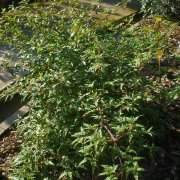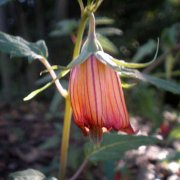Care of the climbing plant Canarina canariensis or Canary Island bellflower |
|
The genus Canarina, family Campanulaceae, includes 3 species of herbaceous climbing plants native to Africa and the Canary Islands. The species are: Canarina canariensis, Canarina abyssinica, Canarina eminii. Common name: Canary Island bellflower. This species is native to the Canary Islands. They are perennial climbing plants with rhizomatous roots and fleshy stems that reach 2 meters (6.56 feet) in height. They have opposite triangular (arrow-shaped) leaves with serrated edges and are light green in color. The interesting hanging flowers are bell-shaped, 5 cm (1.96") long, and orange with red veins. They bloom in late winter and early spring. They produce edible fruits in the form of reddish berries that turn black when ripe. Canary Island bellflower is used as climbing plants in pots for terraces and balconies; needs help to climb (stakes or supports). It can also be grown in hanging pots. Canarina canariensis needs a sheltered and illuminated exposure but without direct sun; in winter the temperature should not be less than 10 ºC (50 ºF). In summer the plant enters a period of rest that lasts 3 months. The soil should be well drained, light, and contain organic matter. Water regularly so that the soil is always moist but never watery; greatly reduce the risks in the resting season to almost eliminate them; water again in autumn. Canary Island bellflower does not need pruning or fertilizers. Canarina canariensis is a plant that is easy to grow and a bit delicate due to its sensitivity to low temperatures; they can be attacked by aphids, insects and cryptogamic diseases. Canary Island bellflower propagates by division of rhizome in late summer or by seeds sown in autumn or spring. |
Images of the climbing plant Canarina canariensis or Canary Island bellflower |
Find plants
Canarina canariensis or Canary Island bellflower | Care and Growing
© 2026 FavThemes



